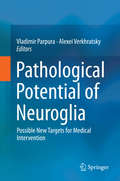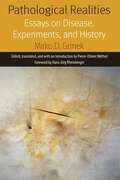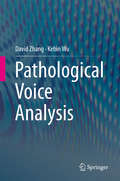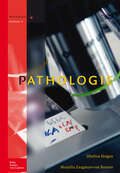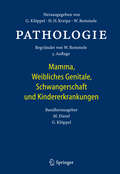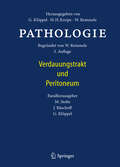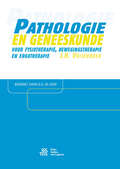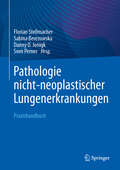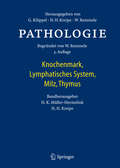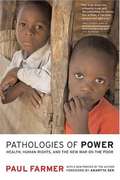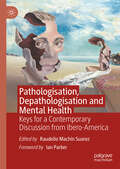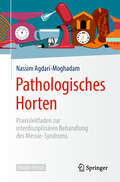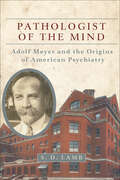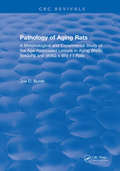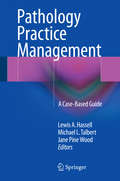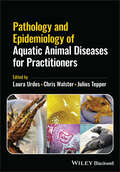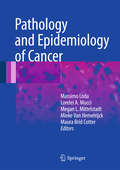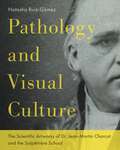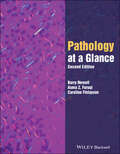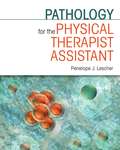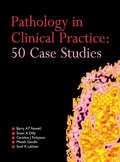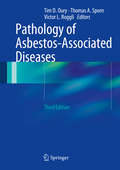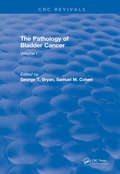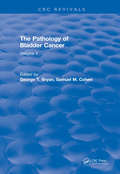- Table View
- List View
Pathological Potential of Neuroglia
by Vladimir Parpura Alexei VerkhratskyPathophysiological states, neurological and psychiatric diseases are almost universally considered from the neurocentric point of view, with neurons being the principal cellular element of pathological process. The brain homeostasis, which lies at the fulcrum of healthy brain function, the compromise of which invariably results in dysfunction/disease, however, is entirely controlled by neuroglia. It is becoming clear that neuroglial cells are involved in various aspects of initiation, progression and resolution of neuropathology. In this book we aim to integrate the body of information that has accumulated in recent years revealing the active role of glia in such pathophysiological processes. Understanding roles of glial cells in pathology will provide new targets for medical intervention and aide the development of much needed therapeutics. This book will be particularly useful for researchers, students, physicians and psychotherapists working in the field of neurobiology, neurology and psychiatry.
Pathological Realities: Essays on Disease, Experiments, and History (Forms of Living)
by Mirko GrmekMirko D. Grmek (1924-2000) is one of the most significant figures in the history of medicine, and has long been considered a pioneer of the field. The singular trajectory that took Grmek from Yugoslavia to the academic culture of post-war France placed him at the crossroads of different intellectual trends and made him an influential figure during the second half of the twentieth century. Yet, scholars have rarely attempted to articulate his distinctive vision of the history of science and medicine with all its tensions, contradictions, and ambiguities. This volume brings together and publishes for the first time in English a range of Grmek’s writings, providing a portrait of his entire career as a historian of science and an engaged intellectual figure. Pathological Realities pieces together Grmek’s scholarship that reveals the interconnections of diseases, societies, and medical theories.Straddling the sciences and the humanities, Grmek crafted significant new concepts and methods to engage with contemporary social problems such as wars, genocides and pandemics. Uniting some major strands of his published work that are still dispersed or simply unknown, this volume covers the deep epistemological changes in historical conceptions of disease as well as major advances within the life sciences and their historiography. Opening with a classic essay – “Preliminaries for a Historical Study of Diseases,” this volume introduces Grmek’s notions of “pathocenosis” and “emerging infections,” illustrating them with historical and contemporary cases. Pathological Realities also showcases Grmek’s pioneering approach to the history of science and medicine using laboratory notebooks as well as his original work on biological thought and the role of ideologies and myths in the history of science. The essays assembled here reveal Grmek’s significant influence and continued relevance for current research in the history of medicine and biology, medical humanities, science studies, and the philosophy of science.
Pathological Voice Analysis
by David Zhang Kebin WuWhile voice is widely used in speech recognition and speaker identification, its application in biomedical fields is much less common. This book systematically introduces the authors’ research on voice analysis for biomedical applications, particularly pathological voice analysis. Firstly, it reviews the field to highlight the biomedical value of voice. It then offers a comprehensive overview of the workflow and aspects of pathological voice analysis, including voice acquisition systems, voice pitch estimation methods, glottal closure instant detection, feature extraction and learning, and the multi-audio fusion approaches. Lastly, it discusses the experimental results that have shown the superiority of these techniques. This book is useful to researchers, professionals and postgraduate students working in fields such as speech signal processing, pattern recognition, and biomedical engineering. It is also a valuable resource for those involved in interdisciplinary research.
Pathologie
by M.J. Zaagman-van Buuren Ij. Jungen De Jong Consulting B.V.In het basiswerk Pathologie worden de pathologische verschijnselen verklaard vanuit de fysiologie. De student leert de verschijnselen en complicaties van ziekten te herkennen, te interpreteren en er adequaat op te reageren. Daarnaast wordt uitvoerig ingegaan op de werking en bijwerkingen van verschillende soorten medicatie om deze te kunnen herkennen en interpreteren.Het basiswerk Pathologie is zorgvuldig afgestemd op Medische fysiologie en anatomie. Het boek biedt de student (en de al afgestudeerde beroepsbeoefenaar) een gedegen basiskennis. De opbouw van het boek ondersteunt het proces waarbij eigen observaties en interpretaties worden gekoppeld aan de medische kennis. Studenten leren zo te beredeneren welke stappen genomen moeten worden in het verpleegkundig handelen.
Pathologie
by Wolfgang Remmele Günter Klöppel Hans H. Kreipe Manfred DietelDer vorliegende Band "Mamma, Weibliches Genitale, Schwangerschaft und Kindererkrankungen" enthält eine systematische Darstellung der pathologischen Veränderungen der genannten Organe, Organsysteme und Erkrankungsgruppen. Dabei werden alle Erkrankungen, die sich in den verschiedenen, zum Teil miteinander funktionell verbundenen, zum Teil unabhängig voneinander existierenden Organen beobachten lassen, beschrieben. Die Verfasser der verschiedenen Unterkapitel sind renommierte europäische Pathologen aus den verschiedenen Arbeitskreisen, die sich mit den o. g. Themen diagnostisch und wissenschaftlich intensiv beschäftigen. Dabei wird insbesondere auf die modernen Entwicklungen der verschiedenen Teilbereiche eingegangen und die neuen Veränderungen in Terminologie, Klassifikation und molekularen Analysen detailliert dargestellt. Dieses stets unter dem Blickwinkel der diagnostischen Pathologie. Insgesamt ist das Ziel der vorliegenden Kapitel, Grundlage und Informationsquelle für die tägliche diagnostische Arbeit auf hohem Niveau zu sein.
Pathologie
by Josef Rüschoff Wolfgang Remmele Manfred Stolte Günter Klöppel Hans H. KreipeDer vorliegende Band "Verdauungstrakt und Peritoneum" enthält die Pathologie des Ösophagus, Magens, Dünndarms und des Kolorektums. Die Verfasser sind renommierte gastroenterologische Pathologen. Die Beiträge folgen in ihrer Didaktik und Gestaltung dem Text der vorausgegangenen Auflagen. Ziel ist es, die Pathologie der Erkrankungen des Gastrointestinaltrakts verbunden mit Epidemiologie, Ätiologie, Pathogenese, Genetik, Klinik und Endoskopie darzustellen. Dem praktizierenden Pathologen soll damit ein Instrument an die Hand gegeben werden, das ihn schnell und adäquat diagnostisch berät und auch über den "seltenen Fall" informiert. Da die Beiträge die morphologischen und differentialdiagnostischen Probleme im Zusammenhang mit den wichtigsten klinisch-diagnostischen Informationen darstellen, ist dieses Buch nicht nur für Assistenzärzte in der Weiterbildung zum Pathologen oder Fachärzte für Pathologie, sondern auch für Studenten, Gastroenterologen, Internisten und Viszeralchirurgen sehr attraktiv.
Pathologie en geneeskunde voor fysiotherapie, bewegingstherapie en ergotherapie
by J. H. VrijenhoekPathologie en geneeskunde voor fysiotherapie, bewegingstherapie en ergotherapie is het eerste leerboek dat uitgaat van het medisch onderwijs aan studenten van fysiotherapie- en andere paramedische opleidingen. In tegenstelling tot andere boeken besteedt dit boek speciale aandacht aan de typische invalshoeken van de paramedische beroepen. Daar waar anatomie, fysiologie en/of biochemie falen, is een gedegen kennis van de pathologie van groot belang voor een juist begrip van klinische ziektebeelden. Dit boek vormt de optimale basis voor elke paramedicus. Het boek bestaat uit twee delen: het eerste deel beschrijft de algemene pathologie en geneeskunde, waar ook gekeken wordt naar de oorzaken en processen die het gehele lichaam kunnen betreffen. Het tweede deel, de speciële pathologie en geneeskunde, beschrijft de ziekteprocessen in de verschillende organen. Daarnaast komen hart- en vaatziekten, longproblematiek, aandoeningen van het bewegingsapparaat, huidziekten en niet-medisch ziekmakende factoren uitgebreid aan bod. In deze zesde druk zijn de terminologie en de lijst van infectieziekten met meldingsplicht geactualiseerd. Daarnaast zijn een aantal medisch specialistische onderzoeken en de oorzaken bij de diverse aandoeningen toegevoegd. Tenslotte is het hoofdstuk over dermatologie fors uitgebreid. Elk hoofdstuk wordt afgesloten met toetsvragen (inclusief antwoorden) om kennis en inzicht in de behandelde stof te toetsen. Dit maakt het boek Pathologie en geneeskunde voor fysiotherapie, bewegingstherapie en ergotherapie ideaal als leerboek. Ook is het boek door de overzichtelijke ordening van de inhoud ook zeer geschikt als naslagwerk.
Pathologie nicht-neoplastischer Lungenerkrankungen: Praxishandbuch
by Sven Perner Florian Stellmacher Sabina Berezowska Danny D. JonigkDas Praxisbuch für die tägliche Diagnostik am MikroskopNeben den klinischen und radiologischen Untersuchungen kommt der histopathologischen Untersuchung von Lungengewebeproben eine entscheidungsrelevante Bedeutung zu. In diagnostisch schwierigen oder zweifelhaften Fällen kann durch die histologische Begutachtung betroffener Lungenareale eine Diagnosesicherung erzielt und therapeutisch relevante Differentialdiagnosen ausgeschlossen werden. Die Diagnostik nicht-neoplastischer Lungenerkrankungen ist oft eine große Herausforderung für den diagnostizierenden Pathologen. Unter den knappen Zeitressourcen aber auch angesichts der stetig zunehmenden Anzahl neu definierter bzw. weiter verfeinerter Entitäten, ist es kaum möglich, den Überblick zu behalten oder gar sämtliche wesentlichen Kriterien zur Diagnosestellung aus der Erinnerung abzurufen. Dieses Buch bietet eine kurze, übersichtliche Darstellung der einzelnen Krankheitsentitäten und der diagnostischen Kriterien für die Untersuchung von Lungengewebeproben. Es begleitet den Pathologen bei der täglichen Arbeit am Mikroskop und erläutert kurz und knapp, welche diagnostischen Kriterien im konkreten Fall greifen und welche Differentialdiagnosen zu beachten sind. Die Autoren legen Wert auf eine standardisierte und übersichtliche Darstellung der einzelnen Krankheitsentitäten. Fallstricken, die zunächst die Diagnose in die falsche Richtung lenken können, werden aufgezeigt. Algorithmen erlauben dem Leser, gezielt den korrekten diagnostischen Pfad einzuschlagen und zügig zur richtigen Diagnose zu finden. Ein einmaliges Praxishandbuch für die tägliche Diagnostik des Pathologen.
Pathologie: Hämatologie, Inkl. Lymphknoten, Milz, Thymus (Pathologie Ser.)
by Hans H. Kreipe Hans Konrad Müller-HermelinkDer vorliegende Band „Knochenmark, Lymphatisches System, Milz, Thymus“ ist mehr als 30 Jahre nach Erscheinen der 1. Auflage inhaltlich und strukturell völlig neu gestaltet worden. Er enthält nicht nur die diagnostische Hämatopathologie der anatomischen Bildungs- und Reaktionsorte des hämopoietischen und lymphatischen Systems, sondern berücksichtigt auch alle Organe mit speziellen hämatopathologischen Erkrankungen wie beispielsweise die Lymphome in den Geweben des Mukosa-assoziierten Immunsystems. Eine Betonung erfährt auch die Darstellung organübergreifender gemeinsamer ätiologischer Faktoren, z.B. der Infektionen. Schließlich werden beim Thymus auch alle epithelialen Tumoren und nichtlymphatischen Erkrankungen diskutiert. Dieses Buch richtet sich an Pathologen und Kliniker mit dem Versuch, die diagnostischen Grundlagen eines zielgerichteten therapeutischen Vorgehens für die reale Situation des Einzelpatienten zu definieren. Die Herausgeber hoffen, dass der vorliegende Band diesem Anspruch gerecht wird.
Pathologies of Calcium Channels
by Norbert Weiss Alexandra KoschakCalcium ions represent Mother Nature's 'ion-of-choice' for regulating fundamental physiological functions, as they initiate a new life at the time of fertilization and guide subsequent developmental and physiological functions of the human body. Calcium channels, which act as gated pathways for the movement of calcium ions across the membranes, play a central part in the initiation of calcium signals, and defects in calcium channel function have been found to result in a plethora of human diseases, referred to as the calcium channelopathies. Pathologies of Calcium Channels brings together leading international experts to discuss our current understanding of human diseases associated with the various calcium channels, from their molecular basis to potential future therapeutic targeting of calcium channels.
Pathologies of Power: Health, Human Rights, and the New War on the Poor
by Paul FarmerPathologies of Power uses harrowing stories of life--and death--in extreme situations to interrogate our understanding of human rights. Paul Farmer, a physician and anthropologist with twenty years of experience working in Haiti, Peru, and Russia, argues that promoting the social and economic rights of the world's poor is the most important human rights struggle of our times. With passionate eyewitness accounts from the prisons of Russia and the beleaguered villages of Haiti and Chiapas, this book links the lived experiences of individual victims to a broader analysis of structural violence. Farmer challenges conventional thinking within human rights circles and exposes the relationships between political and economic injustice, on one hand, and the suffering and illness of the powerless, on the other. Farmer shows that the same social forces that give rise to epidemic diseases such as HIV and tuberculosis also sculpt risk for human rights violations. He illustrates the ways that racism and gender inequality in the United States are embodied as disease and death. Yet this book is far from a hopeless inventory of abuse. Farmer's disturbing examples are linked to a guarded optimism that new medical and social technologies will develop in tandem with a more informed sense of social justice. Otherwise, he concludes, we will be guilty of managing social inequality rather than addressing structural violence. Farmer's urgent plea to think about human rights in the context of global public health and to consider critical issues of quality and access for the world's poor should be of fundamental concern to a world characterized by the bizarre proximity of surfeit and suffering.
Pathologisation, Depathologisation and Mental Health: Keys for a Contemporary Discussion from Ibero-America
by Raudelio Machin SuarezThis book examines the pathologisation and depathologisation of mental health in Ibero-América. It highlights the possibilities and the epistemic limits of the interpretative models of pathos that have legitimised mental health pathologies. Further, it proposes a rereading of psychopathology and analyses the clinical, philosophical, ontological, ethical, psychological and anthropological consequences of this. Across ten chapters it brings together academics from Latin America with colleagues from Europe, Asia and North America to address issues including stigma, aesthetics, childhood, gender, migration, political public or social networks and their relationship with mental health. Section 1 brings critical psychology into dialogue with psychiatry, sociology, philosophy and psychoanalysis to review the conceptual frameworks through which "pathology" has been understood in "psy" discourses. Section 2 presents a range of case studies that demonstrate the impact of debates around the pathologisation and de-pathologisation on mental health care in various populations across Latin American. It will offer fresh insights to practitioners, as well as to students and scholars working in the areas of mental health, critical psychology, medical sociology, Latin American studies, psychiatry and psychoanalysis.
Pathologisches Horten: Praxisleitfaden zur interdisziplinären Behandlung des Messie-Syndroms
by Nassim Agdari-MoghadamDas Messie-Syndrom oder pathologisches Horten – eine neue psychische Störung: Fast jeder Mensch kennt Situationen, in denen es schwerfällt, sich von Gegenständen zu trennen, so dass sich rasch Unordnung ausbreitet. Bei manchen ist das nur eine Lade oder betrifft ausschließlich das Auto oder ein Zimmer. Bei manchen Menschen jedoch betrifft es den gesamten Lebensbereich und führt zu einer massiven Einschränkung der Lebensqualität. Was sind die Chancen und Schwierigkeiten einer psychischen Diagnose? Nach welchen Kriterien kann das Phänomen diagnostisch erfasst werden? Wie entsteht und entwickelt sich das pathologische Horten? Wie kann man Betroffene professionell psychotherapeutisch und psychosozial begleiten und behandeln? Die Autorin diskutiert diese und weitere Fragen auf Basis psychoanalytischer Theorien und leitet daraus praxisnahe Behandlungsempfehlungen für Psychotherapeutinnen, Psychiater und Psychologen ab. Auch für weitere Professionisten multidisziplinärer Teams, wie Hausärzte, Sozialarbeiter und Familienbetreuer, sowie Lehrende und Studierende bietet das Buch wertvolle Informationen.
Pathologist of the Mind: Adolf Meyer and the Origins of American Psychiatry
by S. D. LambIlluminating the contributions of Adolf Meyer, the pioneering father of modern American psychiatry.Winner of the CHOICE Outstanding Academic Title of the Choice ACRLDuring the first half of the twentieth century, Adolf Meyer was the most authoritative and influential psychiatrist in the United States. In 1908, when the Johns Hopkins Hospital established the first American university clinic devoted to psychiatry—still a nascent medical specialty at the time—Meyer was selected to oversee the enterprise. The Henry Phipps Psychiatric Clinic opened in 1913, and Meyer served as psychiatrist-in-chief at Johns Hopkins until 1941. In Pathologist of the Mind, S. D. Lamb explores how Meyer used his powerful position to establish psychiatry as a clinical science that operated like the other specialties at the country’s foremost medical school and research hospital. In addition to successfully arguing for a scientific and biological approach to mental illness, Meyer held extraordinary sway over state policies regarding the certification of psychiatrists. He also trained hundreds of specialists who ultimately occupied leadership positions and made significant contributions in psychiatry, neurology, experimental psychology, social work, and public health. Although historians have long recognized Meyer’s authority, his concepts and methods have never before received a systematic historical analysis. Pathologist of the Mind aims to rediscover Meyerian psychiatry by eavesdropping on Meyer’s informal and intimate conversations with patients and colleagues. Weaving together private correspondence and uniquely detailed case histories, Lamb examines Meyer’s efforts to institute a clinical science of psychiatry in the United States—one that harmonized the expectations of scientific medicine with his concept of the person as a biological organism and mental illness as an adaptive failure. The first historian ever granted access to these exceptional medical records, Lamb offers a compelling new perspective on the integral but misunderstood legacy of Adolf Meyer.
Pathology Of Aging Rats
by BurekThis study presents age-associated pathologic findings in aging rats that had been maintained under similar well-controlled laboratory conditions. The aim of the study was to evaluate two rat strains and their F1, hybrid.
Pathology Practice Management
by Lewis A. Hassell Michael L. Talbert Jane Pine WoodThe authors discuss useful tools and tricks of the trade in pathology practice management. In-depth chapters on coding and billing by nationally known consultant Dennis Padget will prepare you to evaluate coding and billing practices. Noted law experts Jane Pine Wood and Amelia Larsen, attorneys at McDonald Hopkins, highlight key issues in employment, insurance, and hospital contracts and provide examples of how to deal with tricky issues. Sections on human resources and group dynamics take on the vexing issues that people bring to work. Finally, the authors identify current trends and reason how these might play out. In providing a broad overview of pathology practice management, each chapter employs a didactic framework, including one or more scenarios to illustrate challenges encountered by the writers. This case-based approach facilitates interactive learning and will thus be particularly useful to pathology training programs. Whatever your stage in the field--from resident to senior pathologist, including those in leadership roles--Pathology Practice Management: A Case-Based Guide is essential reading.
Pathology and Epidemiology of Aquatic Animal Diseases for Practitioners
by Laura Urdes Chris Walster Julius TepperPathology and Epidemiology of Aquatic Animal Diseases for Practitioners Comprehensive reference on the diseases and applied epidemiology of all aquatic animal taxa, including invertebrates and vertebrates Pathology and Epidemiology of Aquatic Animal Diseases for Practitioners provides information on the diseases and applied epidemiology of all aquatic animal taxa, including invertebrates and vertebrates, along with information on applied epidemiology, acknowledging the One Health concept, and discussion on probabilities of disease outbreaks occurring and assesses the economic costs of treating those outbreaks, if applicable. Divided into two sections, the book looks at the pathology of major aquatic taxa and their associated infectious diseases—parasitic, viral, and bacterial—and non-infectious diseases. Each includes an overview, their host range and transmission, signs and diagnosis, differentials, and treatment and management. These assets are accompanied by clinical signs-lesion differential charts. Sample topics discussed in Pathology and Epidemiology of Aquatic Animal Diseases include: Echinoderms, including crinoidea (crinoids, sea lilies, feather stars, and asteroidea), sea stars/starfish, and ophiuroidea (brittle stars and basket stars) Reptiles, including turtles (freshwater and marine), crocodilians, marine iguanas, and sea snakes Pinnipeds, including otariidae (eared seals), odobenidae (walruses), phocidae (earless seals), mustelidae (otters), and sirenia (manatees and dugongs) Tropical marine aquarium fish (damselfish, angelfish, gobies, wrasses, parrotfish, butterfly fish, and clownfish) and anemones. A highly useful reference for veterinary practitioners, academic staff, and researchers, Pathology and Epidemiology of Aquatic Animal Diseases is also suitable for those who are interested in aquatic veterinary medicine and serves as a companion to Fundamentals of Aquatic Veterinary Medicine, written by the same editorial team.
Pathology and Epidemiology of Cancer
by Massimo Loda Lorelei A. Mucci Megan L. Mittelstadt Mieke Van Hemelrijck Maura Bríd CotterThis book integrates the disciplines of cancer pathology and epidemiology to provide a synergistic and complementary approach to understanding the molecular mechanisms of cancer. This book provides relevant information on the diagnostic, prognostic and predictive molecular pathology of cancer. Epidemiological studies, including descriptive epidemiology, risk factors and molecular mechanisms of disease inform on the etiology and progression of cancer. The text concentrates on major cancers that are currently prevalent and those for which substantial molecular, pathological and epidemiological data is available. Each section is designed to provide an overview of that cancer type in terms of basic biology, review the current epidemiological data surrounding that cancer type and provide information on common practices and challenges related to the molecular pathology of that cancer type. Several relevant techniques in molecular pathology, which facilitate diagnosis and treatment are also explored. Pathology and Epidemiology of Cancer provides a succinct and comprehensive overview of multiple cancer types to guide clinicians during patient care and to guide scientists for innovations in research. It represents an integral resource for pathologists, epidemiologists, medical students as well as translational, basic and clinical science researchers who are all working to progress the field of cancer in terms of diagnosis, treatment and prevention.
Pathology and Visual Culture: The Scientific Artworks of Dr. Jean-Martin Charcot and the Salpêtrière School
by Natasha Ruiz-GómezIn this book, Natasha Ruiz-Gómez delves into an extraordinary collection of pathological drawings, photographs, sculptures, and casts created by neurologists at Paris’s Hôpital de la Salpêtrière in the nineteenth century. Led by Dr. Jean-Martin Charcot (1825–1893) and known collectively as the Salpêtrière School, these savants-artistes produced works that demonstrated an engagement with contemporary artistic discourses and the history of art, even as the artists/clinicians professed their dedication to absolute objectivity.During his lifetime, Charcot became internationally famous for his studies of hysteria and hypnosis, establishing himself as a pioneer in modern neurology. However, this book brings to light the often-overlooked contributions of other clinicians, such as Dr. Paul Richer, who created “scientific artworks” that merged scientific objectivity with artistic intervention. Challenging conventional interpretations of visual media in medicine, Ruiz-Gómez analyzes how these images and objects documented symptoms and neuropathology while defying disciplinary categorization.Grounded in extensive archival research, Pathology and Visual Culture targets an international audience of historians and students of art, visual culture, medicine, and the medical humanities. It will also captivate neurologists and anyone interested in fin-de-siècle French history and culture.
Pathology at a Glance (At a Glance)
by Barry Newell Caroline Finlayson Asma Z. FaruqiFollowing the familiar, easy-to-use at a Glance format and in full-colour, Pathology at a Glance is an accessible introduction and revision text for medical students. Reflecting changes to the curriculum content and assessment methods employed by medical schools, this new edition provides a user-friendly overview of pathology to encapsulate all that the student needs to know. Pathology at a Glance, Second Edition: Addresses the key principles of pathology that are central to medicine Contains full-colour artwork throughout, making the subject easy to understand Presents schematic diagrams on the left page and concise explanations on the right Is divided into three sections, covering general and systematic pathology and clinical case examples Contains self-assessment material, including 10 structured case study questions Covers general pathology mechanisms and the clinical pathology of body systems Provides key information on the epidemiology, pathogenesis and clinical features of the major diseases Revision of many chapters, particularly gynaecological pathology, acute cardiac syndromes, paediatric tumours and haematopathology This book is an invaluable resource for all medical students, of equal benefit for those starting their study of pathology or approaching finals; for junior doctors approaching their membership exams and anybody who needs a handy reference.
Pathology for the Physical Therapist Assistant
by Penelope J. LescherWith other texts written at either too high or too low a level, this book meets the needs of PTA students for usable, understandable pathology related to clinical application. Extensively illustrated, this book allows students to more easily comprehend and maintain interest in otherwise complicated pathological processes. The fourteen chapter format effectively fits within a chapter per week course structure, or each chapter may be used as a stand alone module within any course. And as your students prepare to graduate, encourage them to keep this book to use as a clinically relevant reference as practicing PTAs!
Pathology in Clinical Practice: 50 Case Studies
by Mitesh Gandhi Barry AT Newell Susan Dilly Caroline Finlayson Sunil LakhaniOnce students have learned the principles behind basic pathology and the mechanisms of disease, they must then consolidate their knowledge by putting those principles into clinical practice. Providing a practical learning experience, this volume presents fifty structured clinical scenarios. Each case is based on a clinical situation that pulls toge
Pathology of Asbestos-Associated Diseases
by Tim D. Oury Thomas A. Sporn Victor L. RoggliThe third edition of Pathology of Asbestos-Associated Diseases builds on the success of the previous editions by fully updating knowledge on diagnostic and epidemiologic aspects and presenting important new insights derived from new epidemiologic studies and animal studies. Background information is first provided on the mineralogy of asbestos, occupational and environmental exposure, and asbestos bodies. The various diseases associated with asbestos exposure are then considered in turn, with detailed description and illustration of pathologic features as well as extensive discussion of etiology, epidemiology, differential diagnosis, treatment, and prognosis. Further chapters are devoted to cytopathology, experimental models of disease, analysis of tissue mineral fiber content, and medicolegal issues. This book will be an essential reference for pathologists and an invaluable source of information for pulmonologists, radiologists, and occupational medical practitioners.
Pathology of Bladder Cancer: Volume I (CRC Press Revivals)
by George T Bryan Cohen M SamuelPresent classification schemes of bladder neoplasms are based on structural analyses of histologic material, primarily at the light microscopic level. Attempts to identify histologic variables of certain bladder lesions as biologic precursors of malignancy are in progress. Efforts to relate functional attributes of altered bladder tissues to preneoplastic and neoplastic structural changes are in active development. These advances do require a common recognition and communication of histologic patterns that are used as standard benchmarks. This volume is offered to present in detail description of histologic characteristics of bladder cancer in humans and animals. Areas of recent research advances that may extend our knowledge of the pathobiology of bladder cancer are emphasized. Observations derived from experimental animals are related to the pathogenesis of bladder cancer in humans. This book is intended for pathologists, urologists, oncologists, radiation therapists, epidemiologists, environmental scientists, toxicologists, public health scientists, and regulatory officials.
Pathology of Bladder Cancer: Volume II (CRC Press Revivals)
by Cohen M Samuel Bryan T GeorgePresent classification schemes of bladder neoplasms are based on structural analyses of histologic material, primarily at the light microscopic level. Attempts to identify histologic variables of certain bladder lesions as biologic precursors of malignancy are in progress. Efforts to relate functional attributes of altered bladder tissues to preneoplastic and neoplastic structural changes are in active development. These advances do require a common recognition and communication of histologic patterns that are used as standard benchmarks. This volume is offered to present in detail description of histologic characteristics of bladder cancer in humans and animals. Areas of recent research advances that may extend our knowledge of the pathobiology of bladder cancer are emphasized. Observations derived from experimental animals are related to the pathogenesis of bladder cancer in humans. This book is intended for pathologists, urologists, oncologists, radiation therapists, epidemiologists, environmental scientists, toxicologists, public health scientists, and regulatory officials.
